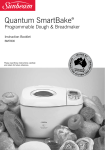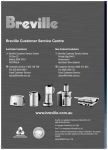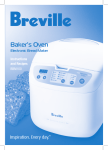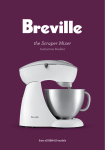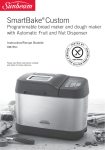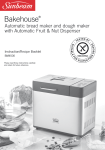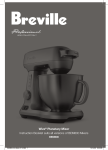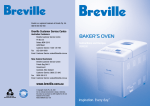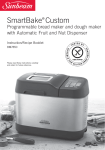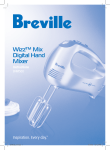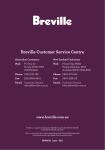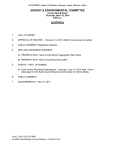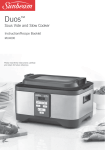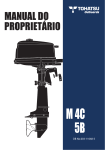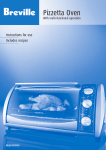Download Kambrook KBM300 Bread Maker User Manual
Transcript
Kambrook - Australia Building 2, Port Air Industrial Estate 1A Hale Street Botany NSW 2019 Australia Customer Service Line 1300 139 798 Customer Service Fax 1800 621 337 www.kambrook.com.au Kambrook - New Zealand Private Bag 94411 Botany, Manukau Auckland 2163 New Zealand Customer Service Line/ Spare Parts 0800 273 845 Customer Service Fax 0800 288 513 www.kambrook.co.nz Due to continual improvement in design or otherwise, the product you purchase may differ slightly from the illustration in this book. Issue D11 Size Select Bread Maker KBM300 Instruction Booklet Contents Important Please retain your instruction book for future use. In the event that you need some assistance with your Kambrook appliance, please contact our Customer Service Department on 1300 139 798 (Australia) or 0800 2738 45 (New Zealand). Alternatively, visit us on our website at www.kambrook.com.au or www.kambrook.co.nz Kambrook Recommends Safety First p4 Know Your Bread Maker p6 Operating Your Bread Maker p7 Beginner’s Guide To Baking Your First Loaf p10 Weighing and Measuring with Your Bread Maker p14 The Vital Ingredients p15 Hints and Tips for Better Bread Making p19 Questions and Answers p21 Control Panel Messages p23 Care, Cleaning and Storage p24 Troubleshooting Guide p26 Recipes p30 Kambrook Recommends Safety First IMPORTANT: Please retain your instruction book for future use. • Do not immerse the bread pan in water. Doing so may interfere with the free movement of the shaft. Wash only the interior of the bread pan. • Do not leave the lid standing open for extended periods of time. • Always ensure the kneading blade is removed from the base of the baked loaf prior to slicing. • Keep the bread maker clean. Follow the cleaning instructions provided in this book. At Kambrook, we believe that safe performance is the first priority in any consumer product, so that you, our valued customer can confidently use and trust our products. We ask that any electrical appliance that you use be operated in a sensible fashion with due care and attention placed on the following important operating instructions. Important Safeguards For Your Kambrook Bread Maker Important Safeguards For All Electrical Appliances • Carefully read all instructions before operating the Kambrook Bread Maker for the first time and save for future reference. • The bread maker is not intended to be operated by means of an external timer or separate remote control system. • C arefully read all instructions before operating the appliance and save for future reference. • Remove and safely discard any packaging material and promotional labels before using the bread maker for the first time. • The lid and outer surface may get hot when the appliance is operating. • R emove and safely discard all packaging material and promotional labels before using the appliance for the first time. • To eliminate a choking hazard for young children, remove and safely discard the protective cover fitted to the power plug of this appliance. • Do not place the bread maker near the edge of a bench or table during operation. Ensure the surface is level, clean and free of water, flour and other substances. Vibration during the kneading cycles may cause the appliance to move slightly. • Do not use the bread maker on a sink drain board. • Do not place the bread maker on or near a hot gas or electric burner, or where it could touch a heated oven. Position the appliance at a minimum distance of 20cm away from walls. This will help prevent the possibility of discolouration due to radiated heat. • Always operate the bread maker on a stable and heat-resistant surface. Do not use on a cloth-covered surface, near curtains or other flammable materials. • Always ensure the bread maker is properly assembled before connecting to a power outlet and operating. Follow the instructions provided in this book. 4 • The temperature of accessible surfaces may be high when the appliance is operating. • Do not touch hot surfaces. Allow the bread maker to cool down before cleaning any parts. • Steam vents are very hot during baking. Do not place anything on top of the bread maker. • Do not cover the air vents when the bread maker is in use. • Use oven mitts when removing the hot bread pan and the bread or jam from the pan. • Take care when pouring jam from the bread pan as the jam is extremely hot. • Do not place any ingredients directly into the baking chamber. Place ingredients into the bread pan only. • Do not place fingers or hands inside the bread maker while in operation. Avoid contact with moving parts. • Ensure that the bread maker is switched off and then unplugged from the power outlet when not in use and before cleaning or storing. • Fully unwind the power cord before use. • D o not let the power cord hang over the edge of a bench or table, touch hot surfaces or become knotted. • T o protect against electric shock, do not immerse the power cord, power plug or appliance in water or any other liquid, unless it is recommended in the cleaning instructions. • T he appliance is not intended for use by persons (including children) with reduced physical, sensory or mental capabilities, or lack of experience and knowledge, unless they have been given supervision or instruction concerning use of the appliance, by a person responsible for their safety. • C hildren should be supervised to ensure that they do not play with the appliance. • It is recommended to inspect the appliance regularly. Do not use the appliance if the power supply cord, plug, connector or appliance becomes damaged in anyway. Return the entire appliance to the nearest authorised Kambrook Service Centre for examination and/or repair. • T his appliance is for household use only. Do not use this appliance for other than its intended use. Do not use in moving vehicles or boats. Do not use outdoors. Misuse may cause injury. • T he installation of a residual current device (safety switch) is recommended to provide additional safety protection when using electrical appliances. It is advisable that a safety switch with a rated residual operating current not exceeding 30mA be installed in the electrical circuit supplying the appliance. See your electrician for professional advice • A lways turn the appliance to the OFF position, switch off at the power outlet and unplug at the power outlet when the appliance is not in use. • B efore cleaning, always turn the appliance to the OFF position, switch off at the power outlet, unplug at the power outlet and remove the power cord, if detachable, from the appliance and allow all parts to cool. • D o not place this appliance on or near a heat source, such as hot plate, oven or heaters. • P osition the appliance at a minimum distance of 20cm away from walls, curtains and other heat or steam sensitive materials and provide adequate space above and on all sides for air circulation. • A ny maintenance other than cleaning should be performed at an authorised Kambrook Service Centre. 5 Know Your Bread Maker 1. 2. 3. 4. 5. 6. Easy view window Cool touch housing 11 easy touch programs Easy touch programming Loaf weight 450g/680g/900g LCD display Operating Your Bread Maker 7. Preset timer 8. Crust selection: Light, Medium and Dark Not Shown • • Automatic keep warm for 1 hour Non-stick baking pan and kneading blade The Control Panel The Control Panel is designed to perform several functions and is activated by switching the Bread Maker on at the power outlet. The LCD Screen indicates the setting and crust colour selection then the completion time for the setting. The various buttons are used to set the functions and to start or stop the bread maker. The buttons should be pressed firmly. A soft beep sound is made as each button is pressed. Fig. 1 LCD Screen The LCD Screen shows firstly a setting (1-11) and crust colour (light, medium or dark) selected, then automatically changes to show the total time for the setting. When the START/STOP button is pressed to commence operation, the time displayed (in hours and minutes) is the time remaining until the selected setting is completed. Menu Press this button to select one of the 11 automatic settings available. These settings are listed on page 8 under “Bread, Loaf and Dough Settings”. Each time the menu button is pressed, the setting is changed and the number of the Preset Setting will be displayed on the LCD screen along with the corresponding time to complete the setting. Crust Press the CRUST button to select the 3 crust colours available for the bread settings only. The colour selected is indicated on the LCD Screen with a ‘-‘ over the crust colour. LIGHT crust colour MEDIUM crust colour DARK crust colour Rapid – This is not a colour setting but a rapid version of the Preset Setting. This is only available for Preset Settings 1-3. Please note the colon [ : ] will begin to flash to indicate that the Setting has commenced. Start/Stop The Bread Maker features a combined START/STOP button. To START: Press the START/STOP button to commence the selected program. To STOP: To stop and cancel the program in mid-cycle the START/STOP button must be pressed down and held for approx. 2 seconds until the beep sounds and the LCD Screen is reset. DO NOT PRESS THE START/STOP BUTTON when checking the bread as this will cancel the program. The machine will not continue to operate in the selected program. 15 hour Preset Timer 6 The Bread Maker has a preset timer control up to 15 hours on Basic (Preset Setting 1), French (Preset Setting 2), Whole Wheat (Preset Setting 3) and Sweet (Preset Setting 4). After selecting a Preset Setting press the [ + ] or [ – ] buttons to increase or decrease the countdown time. For example if you press the [ – ] button it will indicate 15 hours, each time the button is pressed it will decrease in increments of 10 minutes. If you press the [ + ] button it will add 10 minute increments up to 15 hours. Please not that the Time displayed on the LCD screen will include the Preset Setting Cooking time and the delay i.e 4:00 (Setting Time) + 11:00 (Delay) = 15:00 (total). 7 Operating Your Bread Maker continued Bread and Dough Settings Setting 1: Basic When the bread maker is switched on the LCD Screen will show 1 BASIC bread, MEDIUM crust colour. For a DARK or LIGHT Crust colour, press the CRUST button once for DARK, three times for LIGHT. For rapid setting, press the CRUST button ] symbol will be displayed above RAPID on the LCD screen. For twice. The [ the RAPID function, use a 680g loaf recipe for the specified Preset Setting. Setting 2: French Press the MENU button once and the LCD Screen will show 2 FRENCH Bread, MEDIUM crust colour. For a DARK or LIGHT Crust colour, press the CRUST button once for DARK, three times for LIGHT. For rapid setting, press the CRUST button ] symbol will be displayed above RAPID on the LCD screen. For twice. The [ the RAPID function, use a 680g loaf recipe for the specified Preset Setting. Setting 3: Whole Wheat Press the MENU button twice and the LCD Screen will show 3 WHOLE WHEAT bread, MEDIUM crust colour. For a DARK or LIGHT crust colour, press CRUST button once for DARK, three times for LIGHT. For rapid setting, press the CRUST button twice. The [ ] symbol will be displayed above RAPID on the LCD screen. For the RAPID function, use a 680g loaf recipe for the specified Preset Setting. Setting 4: Sweet Press the MENU button three times and the LCD Screen will show 4 SWEET bread, MEDIUM crust colour. For a DARK or LIGHT crust colour, press CRUST button once for DARK, three times for LIGHT. Setting 5: Rapid Press the MENU button four times and the LCD Screen will show 5 SUPER RAPID. Setting 6: Gluten Free Press the MENU button five times and the LCD Screen will show 6 GLUTEN FREE. Setting 7: Loaf Press the MENU button six times and the LCD Screen will show 7 LOAF, MEDIUM crust colour For a DARK or LIGHT crust colour, press CRUST button once for DARK, three times for LIGHT. Setting 8: Dough Press the MENU button seven times and the LCD Screen will show 8 DOUGH. Crust selection is not available on this setting. This setting takes 1 hour 30 minutes to complete. Remove the dough from the bread maker, hand shape, allow to rise again in a warm area then bake in a conventional oven. Setting 9: Pizza Dough Press the MENU button eight times and the LCD Screen will show 9 PIZZA DOUGH Crust selection is not available on this setting. Setting 10: Jam Press the MENU button nine times and the LCD Screen will show 10 JAM Crust selection is not available on this setting. MORE Press the MENU button ten times and the LCD Screen will show 11 MORE Crust selection is not available on this setting. This setting is designed to allow extra baking of up to 1 hour if required. 8 Power Interruption Protection The Bread Maker has a in-built Power Interruption Protection system. If the power is interrupted for 7 minutes or less (by a power failure or accidentally switching off at the power outlet), the program will be automatically resumed when the power is restored. NOTE: Always ensure that there is enough dough or bread in the bread pan when it is inserted in the Bread Maker during a baking cycle or when the MORE setting is selected. Using the MORE Setting The MORE setting of the Bread Maker gives more versatility to your bread making. MORE setting is useful when wishing to: • Extend the baking time if a darker or crisper loaf crust is required. • Crispen loaves already baked and cooled. • Rewarm loaves already baked and cooled. • Delay baking a finished dough. • Melt or crispen toppings. 1. Place the dough or bread into the bread pan and insert into the bread maker. 2. Press the MENU button ten times and the LCD Screen will show 11 and then change automatically to 1:00. 3. Press START/STOP button to commence operation. The MORE setting will bake for 1 hour. This time cannot be altered. If the total hour is not required remove the bread after sufficient time had elapsed and press the START/STOP button to stop operation. 9 Beginner’s Guide To Baking Your First Loaf The following instructions are to be used when making Bread or Dough recipes from the recipe section of this book. All recipes use local ingredients and Australian Standard Metric Measuring tools (cup, spoons and weighing scales) for accuracy in producing a 450g, 680g or 900g loaf of bread. The actual weight of the baked loaf will vary depending on the weight of raw ingredients used. Remove and safely discard any packaging materials and promotional labels before using the Bread Maker for the first time. Step 1: Open the Lid and Remove the Bread Pan Open the lid and remove the bread pan from the Bread Maker by holding, twisting the bread pan and lifting straight up. Step 2: Insert the Kneading Blade It is important that the kneading blade is properly inserted on the shaft in the base of the bread pan by aligning the flat edge on the inside of the kneading blade with the flat side of the shaft. If the blade is not inserted correctly the ingredients may not be mixed and kneaded properly. Step 3: Add Ingredients Into the Bread Pan It is IMPORTANT that the ingredients are added in the correct order listed in the recipe and that the ingredients are measured and weighed accurately or the dough may not mix correctly or rise sufficiently. All ingredients should be at room temperature 20-25°C. Ingredients should be added in the following order: 1. Liquid ingredients 2. Fat/Oil 3. Dry ingredients: salt, sugar, flour 4. Yeast NOTE: Mound the flour into the pan, make a small hollow in the centre and place the yeast there. If the yeast contacts the water before the kneading, the bread may not rise well. Always remove the bread pan from the Bread Maker before adding ingredients to ensure ingredients are not spilt into the baking chamber and the element. Before using for the first time, we recommend that the inside of the bread pan and the kneading blades are washed with warm soapy water, rinsed and dried thoroughly. Do not immerse the bread pan in water. 10 Step 4: Return the Bread Pan to the Bread Maker Insert the bread pan into the Bread Maker as follows: 1. Place the bread pan into the baking chamber and locate the drive mechanism of the pan directly onto the drive mechanism in the baking chamber. 2. Push the bread pan down firmly and turn until it clicks in position. Step 5: Close the Lid It is not recommended to open the lid during operation except to check the consistency of the dough and add additional ingredients in the kneading cycle, or to glaze and add seeds to the top of the loaf in the baking cycle refer below. Step 6: Plug in the Bread Maker Insert the power plug into a 230V or 240V power outlet. Switch on at the power outlet. The LCD Screen will display 1 (BASIC) then automatically change to show the total time 3:25 for the setting (BASIC bread, MEDIUM crust). A red light will illuminate beside the MENU panel. Step 7: Select the Bread Setting and Crust Colour Press the MENU button until the LCD Screen indicates the number of the required setting. The symbol ‘-‘ will also show above the setting in the LCD Screen when a bread Setting is selected. Press the CRUST button once to select DARK crust or three times to select LIGHT crust. The crust selection is available on bread settings 1-4. Step 8: Start the Bread Maker Press the START/STOP button to commence operation. The total setting time will appear on the LCD screen. The setting time will count down in one minute increments. The colon between the hour and the minutes displayed will flash throughout the kneading, rising and baking cycles. The kneading cycles commence. During the kneading cycles beeps will sound indicating the correct time to add other ingredients. Add-In Ingredient Beeper The Bread Maker features an ‘Add-In Ingredient Beeper’ which operates in the BASIC, RAPID, SWEET, FRENCH, WHOLE WHEAT and DOUGH settings. The Bread Maker will sound 10 beeps at approximately 8 minutes before the end of the second kneading cycle, indicating the time to add any additional fruit, nuts, herbs, chocolate, etc. required or as specified in the recipes. The addition of ingredients at this time assists with keeping fruits, etc. whole, rather than being mashed through the dough making it heavy. Open the lid, gradually add the additional ingredients to the dough as it is kneading. Take care not to drop the ingredients over the side of the bread pan into the baking chamber, as these may burn and smoke during the baking cycle. Close the lid. NOTE: Do not press the stop button to add ingredients as this will cancel the selected program. The rising cycles begin when the kneading cycles end and the dough will start to rise. During the rising cycles, the dough will be degassed twice by the blade moving at the end of the first and second rising cycles. The dough rises fully in the third rising cycle. The baking cycle commences when rising cycles end. The dough may rise a little more at this time due to the increasing heat expanding the gasses entrapped in the dough. 11 Beginner’s Guide To Baking Your First Loaf NOTE: RAPID BREAD and DOUGH have two rising cycles with one degassing of the dough. GLUTEN FREE BREAD has only one rising cycle. Steam may also come out of the vents on the lid and obscure the viewing window for a short time. This is a normal part of the bread making process. When the baking cycle has ended, the Bread Maker will sound 5 beeps and the LCD Screen will read 0:00. The bread is now ready to remove. Step 9: Remove the Bread Pan It is recommended to remove the bread at the end of the baking cycle to retain the crispness of the crust. However, if you do not wish to remove the bread immediately, the Bread Maker will automatically go into a Keep Warm cycle, holding the temperature of the bread for up to 60 minutes (except on the dough setting). Five beeps will sound every five minutes throughout the Keep Warm cycle. Step 10: Take the Bread Out of the Bread Pan Use oven mitts to remove the bread pan from the Bread Maker and then gently shake the bread out of the bread pan onto a wire rack. Check that the kneading blade has remained on the shaft in the pan. Place the bread upright on the wire rack to cool. It is recommended to allow the bread sufficient time to cool before slicing. 12 continued NOTE: When baking is finished and the bread has been removed from the bread pan, remove the kneading blade from the pan using oven mitts. Do not remove the blade with bare hands, as it is very hot! If the kneading blade is difficult to remove from the driveshaft, pour some warm water with detergent into the pan and allow to stand for 10 minutes. The kneading blade should then be easily removed from the shaft. Follow care and cleaning instructions on page 24. Step 12: Cut the Bread Before cutting the bread, check that the kneading blade has been removed from the bottom of the baked bread. When the bread is cool, using a serrated-edge knife or electric knife on a firmly-seated breadboard. A standard blade knife is not suitable as it will tear the bread. Step 13: Store the Bread Store the bread in a freezer bag or a sealable bread box. To store for more than a few days, place the bread into a freezer bag, expel the air, seal, label and date. Bread may be frozen for up to 1 month. Step 11: Switch off and Unplug the Bread Maker Press the START/STOP button on the Bread Maker. The LCD Screen will reset to 1. Switch off at the power and remove the plug. If wishing to make another loaf of bread, allow approximately one hour for the Bread Maker to cool before using again. Leave the lid open to help the machine cool. If the Bread Maker is too hot it will display an error code E01 and rapid beeps will sound. The Bread Maker cannot be reprogrammed until the correct operating temperature for kneading has been reached. To store the Bread Maker ensure it is completely cool, clean and dry. Place the bread pan and kneading blade into the baking chamber and close the lid. Do not place heavy objects on the lid. Store the Bread Maker upright. 13 Weighing and Measuring with Your Bread Maker The Vital Ingredients Baking bread is in part a science and each ingredient plays an important role. Care should be taken when weighing and measuring ingredients to ensure accuracy and consistency. Recipes in this Instruction Book were developed using Australian Metric Weights and Measurements. Flour Australian Metric Measurements mls 1 teaspoon 5 1 tablespoon 1 cup 20 250 NZ Metric Measurements mls 1 teaspoon 5 1 tablespoon 15 1 cup 250 NOTE: The New Zealand tablespoon is 5ml less than the Australian tablespoon, so care should be taken when measuring ingredients to compensate for this variance. For example, 1 Australian tablespoon = 1 New Zealand tablespoon plus 1 New Zealand teaspoon. Metric Liquid Measuring Jugs If measuring liquids using a graduated, metric measuring jug, place jug on a flat surface and check for accuracy at eye level. DO NOT USE TABLEWARE JUGS OR MEASURING CUPS. 14 NOTE: It is important to note that New Zealand ingredients, especially flour and yeast, differ from the Australian equivalents. In the Vital Ingredients section (pages 15-18) suitable New Zealand products have been listed. We suggest these New Zealand products be substituted for the Australian products in the Recipe section. Metric Weighing Scales For consistent results it is recommended to use metric weighing scales if possible as they provide greater accuracy than measuring cups. Tare (or zero) the scales with the container in position then spoon or pour ingredients in until the desired weight is achieved. NOTE: In general, water weighs the same in grams as it measures in millilitres. Metric Measuring Cups and Spoons If using graduated, metric measuring cups, it is important to spoon in or scoop the dry ingredients loosely into the required cup. Do not tap the cup on the bench, or pack the ingredients into the cup, unless otherwise directed. Level the top of the cup with a knife. When using graduated, metric measuring spoons, level the top of the spoon with a straight edged knife or spatula. DO NOT USE TABLEWARE SPOONS OR CUPS. Flour is the most important ingredient used for bread making. It provides food for the yeast and structures the loaf. When mixed with liquid, the protein in the flour starts to form gluten. Gluten is a network of elastic stands, which interlock to trap the gases produced by yeast. This process increases as the dough undergoes kneading and provides the dough with the structure required to produce the weight and shape of the bread. White Wheat Flour The flour used in the Bread Maker should be bread or baker’s flour. There is no need to sift the flour. Plain flour is most readily available, however best results are obtained with flour that has 11-12% protein. For this reason, the recipes in this book requiring bread flour, have been made with flours with 11-12% protein content. This is normally indicated on the packaging. Do not use self-raising flour unless indicated on the recipe. NOTE: When using a low protein, stone ground, wholemeal or plain flour the quality of the bread can be improved by adding gluten flour. Baker’s Or Bread Flour Several brands of baker’s or bread flour are available nationally at larger supermarkets. Baker’s flour was used for the development of most of the recipes contained in this guide. It is a high protein, white wheat flour, with 11-12% protein content, ensuring a higher quality and consistency to the baked bread. NOTE: NEW ZEALAND ONLY: ‘Elfin High Grade White Flour’ or ‘Champion High Grade Flour’. These are high protein, white bread flours, containing 12% protein. Wholemeal Flour Contains all the bran, germ and flour of the whole wheat grain. Although breads baked with this type of flour will be higher in fibre, the loaf can be lower in height and heavier in texture depending on the protein level of the flour. Wholemeal flour with low protein can be improved by adding gluten flour or replacing 1 cup of wholemeal flour with bread or baker’s flour. Rye Flour Popular for continental bread making, rye flour is low in protein and so it is essential to combine rye flour with bread flour to make bread successfully in the bread maker. Rye flour is traditionally used to make Pumpernickel and Black breads. Gluten Flour Gluten flour is a concentrated mixture of gluten forming protein and wheat flour. Adding gluten flour can improve the structure and volume of bread when using a low protein, stone ground, wholemeal or plain flour. Gluten flour can be purchased at most health food stores. 15 The Vital Ingredients continued Bread Mixes Sugar Yeast These convenient mixes contain bread flour, sugar, milk, salt, oil and other ingredients such as bread improvers. Usually only the addition of water and yeast is required. Bread mix brands such as “Defiance”, “Laucke” and “Kitchen Collection” are available nationally from major supermarkets. For information on other brands of bread mix contact the manufacturer listed on the package. Sugar provides food for the yeast, sweetness and flavour to the crumb and helps brown the crust. White sugar, brown sugar, honey and golden syrup are all suitable to use. When using honey or golden syrup it must be counted as additional liquid. We have successfully tested granulated ‘SPLENDA’ as a sugar substitute. Without yeast the bread will not rise. Yeast needs liquid, sugar and warmth to activate. Dried yeast has been used in the recipes in this instruction book where appropriate. Before using dried yeast, always check the use-bydate, as stale yeast will prevent the bread from rising. “Tandaco” brand yeast (available nationally in most supermarkets) was used in the development of all yeasted recipes contained in this book. Smaller packets of bread mix usually contain sachets of yeast. Larger bulk bags of bread mix usually do not include the yeast sachets, however the corresponding brand of yeast may be purchased separately. Some bulk and imported yeasts are more active, therefore it is recommended to use less of these yeasts. Yeast may also be more active in hot weather. For information on other brands of yeast relating to quantities contact the manufacturer listed on the package. NOTE: NEW ZEALAND ONLY: Bread mix brands such as ‘Elfin’ are available. Bread Improver Several brands of bread improvers are available nationally in supermarkets and health food stores. The ingredients in a bread improver are usually a food acid such as ascorbic acid (Vitamin C) and other enzymes (Amylases) extracted from wheat flours. NOTE: Adding a bread improver will help strengthen the framework of the bread resulting in a loaf that is lighter in texture, higher in volume, more stable and with enhanced keeping qualities. A crushed unflavoured Vitamin C tablet or Vitamin C powder can be used as a bread improver and added to the dry ingredients. 16 NOTE: NEW ZEALAND ONLY: Sugar can be reduced for more improved results. Powdered Milk Milk and milk products enhance the flavour and increase the nutritional value of the bread. Powdered milk is convenient and easy to use (store in an airtight container in the refrigerator). Fresh milk should not be substituted for powdered milk unless stated in the recipe. Low fat or skim milk powder can be used with good results. Soy milk powder can also be used by produces a denser loaf. Salt Salt is an important ingredient in bread making. However, salt inhibits the rising of the bread, so be careful when measuring, as it should be accurate. Fat Butter, margarine or oils, such as vegetable, safflower, sunflower, canola, etc., will add flavour, retain the moisture and enhance the keeping qualities of the bread. NOTE: NEW ZEALAND ONLY: We recommend the use of ‘Elfin’ brand yeast. Rapid Rise Yeast There products are a mixture of yeast and bread improver. Brands will vary in strength. If wishing to substitute for yeast in a recipe, omit the bread improver. Rapid rise yeasts should not be used with bread mix as bread improver is already included. NOTE: NEW ZEALAND ONLY: ‘Edmonds Surebake Yeast’ is the most readily available yeast product in New Zealand. Where a recipe states ‘Bread Improver and Tandaco Yeast’ substitute with ‘Edmonds Surebake Yeast.’ Water Tap water is used in all recipes. If using water in cold climates or from the refrigerator, allow water to come to room temperature. Extremes of hot or cold water will prevent the yeast activating. Eggs Eggs are used in some bread recipes and provide liquid, help with the rising and increase the nutritional value of the bread. They give flavour and tenderness and are usually used in the sweeter type of breads. Other Ingredients Fruit, nuts, chocolate chips, etc. are added when the Bread Maker sounds 10 short beeps approximately 8 minutes before the end of the second kneading when using the BASIC, RAPID, WHOLE WHEAT, FRENCH, SWEET and DOUGH settings. If added before this stage, excessive kneading will cause the ingredients to break down rather than hold their shape. 17 The Vital Ingredients continued For more information about bread mixes please contact the relevant number listed below, or refer to contact details on the packaging of the bread mix. Defiance: 1800 628 883 Laucke: 1300 133 331 Kitchen Collection: 1800 645 515 Elfin (New Zealand only): 0800 110 800 For more information about Bread or Baker’s Flour please contact the relevant number listed below, or refer to contact details on the package. Defiance White Baker’s Flour: 1800 628 883 Laucke Wallaby Baker’s Flour: 1300 133 331 Elfin/Champion High Grade Plain Flour (New Zealand only): 0800 110 800 For more information about Bread Improver please contact: Lowan Wholefoods: 1800 355 718 Hints and Tips for Better Bread Making Do's • • • • • • Don'ts • • • • • • 18 Do measure ingredients accurately – weighed measurements are more accurate than volumetric measurements. Do use bread flour unless recipe states otherwise. Do check use-by-dates on ingredients. Do add ingredients to the bread pan in the order stated in the recipe. Do store opened ingredients in airtight containers. Do use ingredients at room temperature. Don’t use flour that contains a protein level of less than 11%, for example, generic brands of plain flour. Don’t use tableware cups and spoons for measuring. Don’t use compressed yeast. Don’t use hot water or liquids. Don’t use metal objects to remove the kneading blade from the cooked loaf of bread or the bread pan as this may cause damage to the non-stick coating. Don’t operate the machine if any ingredients have spilled over or around the element. Wipe away any spills first to prevent smoking occurring in the baking cycle. WARNING: Use the PRESET TIMER for recipes that contain perishable items, such as eggs, cheese, milk, cream and meats. WARNING: Never immerse your Bread Maker or bread pan in water. NOTE: If you live in an area with a high altitude (above 900m) you will probably need to alter your bread recipe, as the higher the altitude, the lower the air pressure, the faster the dough will rise. Try reducing the yeast by ¼ teaspoon. NOTE: If the weather is hot and humid, reduce the yeast by ¼ teaspoon to avoid over rising of the dough. 19 Hints and Tips for Better Bread Making NOTE: Flour properties can alter on a seasonal or storage basis, therefore it may be necessary to adjust the water and flour ratio. This can be determined after ten minutes of the kneading cycle. Simply open the lid of the Bread Maker and if the dough is too sticky, add a little more flour, 1 tablespoon at a time, until the dough reaches a firmer consistency. If the dough is too dry add a little more water, 1 teaspoon at a time until a softer, more pliable dough results. After being properly kneaded, dough with the correct amount of water should form into a smooth, round ball. NOTE: When hand-shaping dough for rolls, weigh each piece of dough for more evenly sized rolls. NOTE: Do not underfill or overfill the bread pan as the bread may not mix properly. The recipes in this book have been especially designed and tested to produce 0.45kg to 0.9kg (1lb to 2lb) loaves. As a general guide, a maximum 650g flour and 7.5g (1½ teaspoons) yeast are recommended to ensure the dough does not rise over the bread pan. On the jam setting, a maximum 2 cups of fruits should be used. 20 continued Questions and Answers About Ingredients: Q. Can other bread recipes be made in this machine? A. The recipes in this book are sized so that the dough is kneaded properly and the finished bread does not exceed the bread pan capacity. Use only recipes will similar quantities of ingredients. Q. Can fresh milk be used instead of dry milk? A. Yes. bread made with fresh milk will have a heavier texture than bread made with milk powder. If using fresh milk substitute the water with fresh milk and omit the milk powder. Scald the milk then cool before adding to the other dough ingredients. Q. Can butter or margarine be used in place of oil? A. Yes, but the bread crumb may appear a more creamy or yellow colour. Q. Can other sweetening agents be used in place of sugar? A. Yes, honey, golden syrup or brown sugar can be used. Do not use powdered or liquid artificial sweeteners. However granulated ‘SPLENDA’ was successfully tested during recipe development. When substituting honey or similar sweet liquids for sugar, reduce the water by the same amount. Q. Can salt be omitted? A. Salt plays a very important part in bread making. Omitting it will decrease water retention in the dough, as well as affect mixing, the strength of the gluten development and the fermentation of the yeast. In the finished bread, salt improves the loaf shape, crumb structure and crust colour, as well as extending shelf life and enhancing flavour. Q. Why do the ingredients need to be placed into the pan in the specified order? A. To ensure all dry ingredients are mixed with water and to avoid the yeast activating prematurely with the water when using the PRESET TIMER. About Baking Bread: Q. The programmed setting has been interrupted by a power failure or switched off at the power outlet during the bread making process. What can I do? A. If the power is accidentally turned off for 5 minutes or less during the operation, the Bread Maker has a 7 minute memory function, that will automatically resume bread making, where it was interrupted, when power is restored. If the operation cannot be resumed or the setting is cancelled: During the kneading stage – Re-select the bread setting again and allow dough to re-knead and continue through the rising and baking process. The result may be a loaf higher in volume and lighter in texture. During the rising stage – Turn the bread maker off. Leave the dough in the pan and in the baking chamber with the lid closed. Allow the dough to rise until almost near the top of the pan. Turn the bread maker on. Select the MORE setting. Press the START/STOP button. During the baking cycle – Select the MORE setting. Press the START/ STOP button. 21 Questions and Answers Q. What happens if the bread isn’t removed when the bake cycle is complete? A. The Bread Maker will automatically go into a keep warm cycle, (in the BASIC, RAPID, WHOLE WHEAT, GLUTEN FREE, FRENCH and SWEET settings) holding the temperature of the bread for up to 60 minutes. However, as the loaf cools it gives off steam which cannot escape from the bread pan. The bread crust may become soft and the loaf may slightly lose its shape. Q. Why did the bread not rise? A. There may be several reasons. Check the protein level of the flour and the use-by-date of the yeast and the flour. The yeast may have failed to activate, the yeast measurements may be inaccurate or sometimes people just forget to add the yeast. Q. Why do large holes appear inside the bread? A. Occasionally air bubbles will concentrate at a certain location during the last rising and will bake in that state. This could be caused by too much water and/or yeast or insufficient flour. Check the recipe ingredients and method of weighing/measuring. Q. Why does the top of the bread collapse? A. Usually this is because the ingredients are not in balance or a low protein flour is used. Check the method of weighing/ measuring the ingredients. Too much yeast, water or other liquid ingredients, or insufficient flour, may cause the bread to be pale on top and collapse while baking. 22 continued Q. Why does bread colour differ? A. This is probably because the ingredients in each recipe differs. A different crust colour may also have been selected. Q. Are the room and water temperatures important? A. Yes, room and water temperature influences yeast activity and therefore can affect the quality of your bread. The average room temperature is approximately 2025°C. Water at room temperature should also be used. Control Panel Messages Error Detection When the Start/STOP button has been pressed to begin the process and there is a problem relating to the sensor, beeps will sound twice and then the LCD Screen will flash the particular error message specific to the problem. There are 4 different error messages: Error Message Problem Correction E01 Attempting to use the Bread Maker shortly after a loaf has been baked and its interior will still be warm, that is the sensor temperature will still be above 50°C. Press START/STOP to reset, open the lid, remove the bread pan and allow the oven cavity sufficient time to cool. Refer to “Beginner’s Guide to Baking Your First Loaf” step 11, page 10. E00 The Bread Maker is used in an extremely cold environment below -10°C. Place the bread maker in a warmer environment. Recommended room temperature 20-25ºC. NOTE: NEVER use hot water as it will kill the yeast. EEE Contact your nearest authorised Kambrook Service Centre (refer to the back page for details). HHH Contact your nearest authorised Kambrook Service Centre (refer to the back page for details). 23 Care, Cleaning and Storage Before cleaning your Bread Maker, switch off and then unplug from the power outlet and allow the bread maker to cool completely. Bread Maker The inside and outside of the Bread Maker and lid should be wiped with a soft, damp cloth then dried thoroughly. If overspills, such as flour, nuts, sultanas, etc. occur in the baking chamber, carefully remove, using a damp cloth. Before re-using your bread maker ensure that all parts are completely dry. NOTE: NEVER immerse the Bread Maker, lid, kneading blade or the bread pan in water or place in the dishwasher. Take care not to allow water or cleaning fluids to seep under the buttons or LCD screen on the control panel. Bread Pan and Kneading Blade The inside of the bread pan and kneading blade are coated with a high quality, non-stick coating. As with any non-stick coated surface, NEVER use metal utensils or abrasive cleaners on these items. To Clean the Bread Pan and Blades: Replacement Bread Pan and Blade NOTE: Do not immerse the outside of the bread pan in water as this may interfere with the free movement of the wing-nut and drive shaft. Submerge and wash only the interior of the bread pan. Both the blade and bread pan coating are operating parts of the Bread Maker and as such are subject to normal wear and tear over the life of the maker. Depending on your usage of the Bread Maker they may need replacement if the bread begins to stick. Spare Parts WARNING: Do not use harsh cleaners, abrasives, brushes or steel wool. Replacement parts are available from Kambrook Spare Parts: Australia Customer Service: 1300 139 798 Never wash the bread pan or kneading blade in the dishwasher. NOTE: Some discolouration may appear on the bread pan over time. This is a natural effect cause by moisture and steam and will not affect the bread in any way. Storage When storing the Bread Maker, switch off and then remove the power plug from the power outlet. Ensure it is completely cool, clean and dry. Place the bread pan and kneading blades into the baking chamber and close the lid. Do not place heavy objects on top of the lid. Store the Bread Maker. Half fill the pan with warm soapy water (use a non-abrasive detergent), allow to stand for 10-20 minutes. Remove the kneading blade and clean both blade and inside of bread pan using a soft cloth. Be sure to remove any crust or dough that may become lodged around the drive shaft and the kneading blade. 24 25 Troubleshooting Guide Bread sinks in the centre Over browned Sticky patch on top of bread Doughy centre Heavy dense texture Not measured correctly Not measured correctly • • • • Low % protein Low % protein • Passed use-bydate Passed useby-date • Self raising flour used Self raising flour used • Sugar Not measured correctly Not measured correctly • Salt Not measured correctly Not measured correctly • Not measured correctly • Too hot • Problem Flour Water/liquid Coarse holey texture Bread rises too much Bread doesn’t rise enough Corrective action • • Check method of weighing/measuring ingredients • Use suitable high protein flour or add gluten flour • • Discard and use fresh flour • • • Use bread or plain flour - self-raising flour already contains baking powder as the raising agent • • • Use metric measuring spoons • Use metric measuring spoons • Check method of weighing/measuring • Water must be between 20-25ºC • Water must be between 20-25ºC • Use metric measuring spoons • • • • • • • • Too cold Yeast Bread mix Room temperature 26 Not measured correctly • • Not measured correctly • • • • • • • Check method of weighing/measuring Used in place of flour • • • • • • • Bread mix already contains salt, sugar, etc. and cannot be substituted for flour Too hot • • • Room temperature must be less than 28ºC Too hot • • Room temperature must be more than 10ºC • 27 Troubleshooting Guide Problem Maker will not operate Appliance unplugged • continued Error code E01 on LCD Screen Kneading blade not on shaft Ingredients not mixed Bread not baked • • Baked bread is damp Power interruption • • • • • Loaf is small • • • • Hot bread left in pan too long • • • Incorrect crust colour selection 28 Bread not sufficiently baked • Lid opened during rising or baking Bread pan unseated PRESET TIMER did not function • • START/STOP button pressed after starting maker START/STOP button not pressed Under browned crust • Selected setting incorrect Maker has not cooled from previous use Bread rises too much • • • • • • 29 Recipes Basic Recipes French Recipes Wholewheat 900g loaf – Medium - Basic 900g loaf – Medium - French 900g Loaf – Medium – Whole wheat Ingredients Ingredients 380ml water 40ml oil 2 teaspoons salt 2 tablespoons sugar 650g flour 2 tablespoons milk powder 1 teaspoons bread improver 1½ teaspoons yeast 380ml water 15ml oil 2 teaspoon salt 2 teaspoon sugar 650g flour 1 teaspoon bread improver 1½ teaspoon yeast 410ml water 50ml oil 2 teaspoon salt 3 tablespoons sugar 535g wholemeal flour 125g white flour 2 tablespoons milk powder 1 teaspoon bread improver 2¼ teaspoons yeast 680g Loaf – Medium - Basic Ingredients 320ml water 30ml oil 1½ teaspoons salt 1½ tablespoons sugar 450g flour 1 tablespoons milk powder ¾ teaspoon bread improver 1¼ teaspoons yeast 450g loaf – Medium - Basic Ingredients 195ml water 20ml oil 1 teaspoon salt 1 tablespoon sugar 325g flour 1 tablespoon milk powder ½ teaspoon bread improver 3/4¾ teaspoon yeast 30 680g Loaf – Medium - French Ingredients 300ml water 10ml oil 1½ teaspoon salt 1½ teaspoon sugar 500g flour ¾ teaspoon bread improver 1¼ teaspoon yeast 450g loaf – Medium - French Ingredients 195ml water 5ml oil 1 teaspoon salt 1 teaspoon sugar 325g flour ½ teaspoon bread improver ¾ teaspoon yeast 680g Loaf – Medium – Whole wheat 320ml water 40ml oil 1½ teaspoons salt 2½ tablespoons sugar 400g wholemeal flour 110g white flour 1½ tablespoons milk powder ¾ teaspoon bread improver 2 teaspoons yeast 450g Loaf – Medium – Whole wheat 205ml water 25ml oil 1 teaspoon salt ½ tablespoon sugar 265g wholemeal flour 60g white flour 1 tablespoon milk powder ½ teaspoon bread improver 1½ teaspoons yeast Sweet Bread – All Recipes Done On 900G, Medium, Sweet Setting. Lime and Poppy seed Bread 310ml water ½ cup orange juice 3 tablespoons lime marmalade 1½ tablespoons oil 2 teaspoons salt 700g bread flour 1 teaspoon bread improver 2 tablespoons milk powder 1 tablespoon poppy seeds 1½ teaspoons yeast Mediterranean Bread 400ml water 200gms semi sundried tomatoes, with oil ½ cup olives, seeds removed, halved 2 teaspoons salt 2 tablespoons sugar 650g bread flour 1 teaspoon bread improver 2 tablespoons milk powder 1½ teaspoons yeast Peanut Butter Chocolate Bread 350ml water 50ml oil 2 tablespoons peanut butter 2 teaspoons salt 2 ½ tablespoons sugar 600g bread flour 2 tablespoons cocoa powder 1 teaspoon bread improver 2 tablespoons milk powder 1½ teaspoons yeast 31 Recipes Strawberry Vanilla Bread Potato Rosemary Bread 350ml water 1 tablespoon oil 1 teaspoon vanilla bean paste 2 teaspoons salt 610g bread flour 3 tablespoons strawberry jam 1 teaspoon bread improver 2 tablespoons milk powder 1½ teaspoons yeast 350g water 2 tablespoons oil 2 teaspoons salt 1 tablespoon sugar 600g bread flour 1 teaspoon rosemary, chopped ½ cup mozzarella cheese, shredded 1 teaspoon bread improver 2 tablespoons milk powder 1½ teaspoons yeast 1 cup baked potatoes, diced Passion fruit Coconut Bread 320ml water 170g passion fruit pulp 1 tablespoon oil 2 teaspoons salt 2 tablespoons sugar 600g bread flour ½ cup shredded coconut 1 teaspoon bread improver 2 tablespoons milk powder 1½ teaspoons yeast Sweet Chilli, Pine nut and Coriander Bread 350ml water 2 ½ tablespoons oil 3 tablespoons sweet chilli sauce 2 teaspoons salt 1 tablespoon sugar 600g flour 65g pine nuts ½ cup coriander leaves 1 teaspoon bread improver 2 tablespoons milk powder 1½ teaspoons yeast NOTE: Baked potatoes are to be placed on top of dough just before the ‘bake setting’ Slits should be made into the top of the dough ball and then the potatoes placed on top to ensure even cooking. Jam Setting Pasta Sauce Makes 4 serves NOTE: As a general guide, a maximum 650g flour and 1½ teaspoons yeast are recommended to ensure the dough does not rise over the bread pan. On the jam setting, a maximum 2 cups of fruits should be used. 400gms tomato, diced 1 onion, diced 2 clove garlic, minced 1 tablespoon balsamic vinegar 1 tablespoon sugar 2 teaspoons salt 1 bunch basil, washed, leaves only Chilli Sauce Makes 2 jars 190g sultanas 4 tablespoons brown sugar 2 teaspoons salt ½ cup white vinegar 1 capsicum, diced 385g chillis, chopped 2 cloves garlic, minced 1 teaspoon ginger, minced Tomato Chutney Makes 2 jars 6 roma tomatoes, diced 1 spanish onion, sliced 1 clove garlic, minced ¼ cup balsamic vinegar 2 tablespoons red wine vinegar ¼ teaspoon smoked paprika 2 tablespoons brown sugar 1 teaspoon salt Orange Rum Marmalade Makes 2 jars 2 oranges 2 tablespoons rum ½ cup jam setting sugar 1 cup sugar 32 33 Recipes Loaf Setting Brownies Makes 12 125g butter, melted 1 cup brown sugar, firmly packed 125g dark chocolate, chopped, melted 3 eggs, lightly whisked 1 ⁄3 cup plain flour 1 ⁄3 cup cocoa powder ¼ teaspoon baking powder 1. Place all ingredients into a bowl and stir until combined. 2. Place into the bread pan without the kneading blade 3. Select ‘loaf’ setting and cook. 4. Allow to cool and cut into slices. Red Wine Pears Serves 2 1 cup red wine ½ cup orange juice 2 tablespoons sugar syrup 1 teaspoon orange rind 1 cinnamon quill 6 cloves 2 pears, peeled and cored 1. Place all ingredients into the bread pan without the kneading blade. 2. Cook on ‘loaf’ setting. 3. Allow to cool slightly and serve with ice cream. NOTE: For a thicker syrup, remove pears, add ½ cup jam setting sugar and ½ cup sugar and place onto ‘jam’ setting. Serve on pears, scones or use as cordial. 34 Rapid Setting Pizza Dough Setting Rapid Pizza Dough 285ml water 2 tablespoons olive oil ¾ teaspoon salt 1½ tablespoons sugar 570g bread flour 1 tablespoon milk powder 1 teaspoon bread improver 1 teaspoon yeast 375mls warm water 60ml olive oil 1 teaspoon sugar 1 teaspoon salt 600g bread flour 2 teaspoons yeast Gluten Free Setting Standard Gluten Free Loaf 300ml water 60ml oil 3 x 59g eggs 1 teaspoon apple cider vinegar 320g white rice flour 270g potato flour 75g arrowroot ½ cup caster sugar 1½ teaspoons salt ½ cup milk powder 1 tablespoon Guar or Xanthan gum 2 teaspoon yeast Gluten Free Pizza Dough 400ml water 40ml oil 600g gluten free flour 1 tablespoon sugar 1 teaspoon salt 1 teaspoon Guar or Xanthan gum 2 teaspoons yeast Dough Dough 380ml water 40ml oil 2 teaspoons salt 2 tablespoons sugar 650g flour 2 tablespoons milk powder 1 teaspoons bread improver 1½ teaspoons yeast 35


















